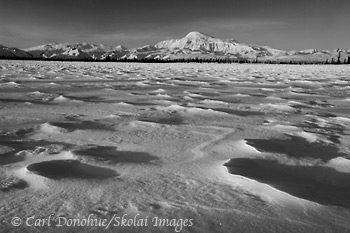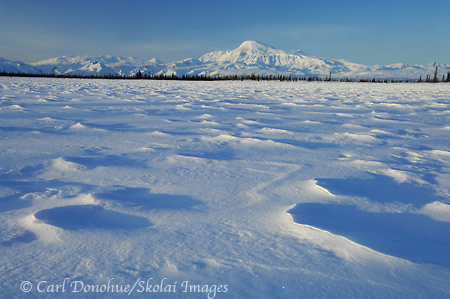
Black and white photo of Mount Sanford, one of the highest peaks in the Wrangell Mountains, at dawn, from a small frozen kettle pond. Winter snow creates patterns on the frozen lake. Mt. Sanford, Wrangell-St. Elias National Park and Preserve, Alaska. Please click on the thumbnail above to view a larger version of this photo.
Hey Folks,
Here’s an image of Mount Sanford, Wrangell-St. Elias National Park and Preserve, I took a while ago, that I converted to black and white in photoshop. I shot this after the alpenglow had faded, and the sun rose high enough in the sky to light up not just Mount Sanford’s massive peak, but the entire floor of the Copper River Basin.
It’s very easy to be tempted to pack up and head off after the alpenglow on a mountain wanes; I often find the light immediately following the alpenglow to be unappealing to me. The sky has a weird yellowish tint to it, and the contrast between the dark, shaded foreground and the brightly lit peak is too great to really photograph well; for me, anyway.
It can take as long as an hour for the light to reach the foreground, depending on the location, time of year, etc, and that time often feels like the longest part of the day. Standing, waiting, wishing, hoping, filling in time until the sun rises high enough to light up the valley floor. Add to that it’s cold, I’m tired and hungry, and I already witnessed (and photographed) the gorgeous alpenglow earlier, and I’ve got plenty of reason to move along.
However, it’s often worth waiting. I find the light improves again, usually soon after the sunlight hit the floor. The sky turns a great, soft blue, the sidelit landscape glows and the play of shadow and light can be very dramatic. It’s hard to beat really nice alpenglow, but that early sidelight comes close, I think.
The repeating windblown snow patterns on the surface of this frozen lake appealed to me as a foreground subject. I liked that their angle and shape seems to reflect that of Mount Sanford in the distance; the harmony and rhythm of that interplay provides a wonderful complimentary balance to the frame, for me.
I converted this to black and white largely because I thought the simple graphic nature of the image was strength here; shapes, patterns, rhythms, etc. I find those elements to be reinforced and strengthened by removing the color. It still works nicely as a color photo though. I’ll post a color version below:
Which image do you prefer, and why?
Cheers
Carl
